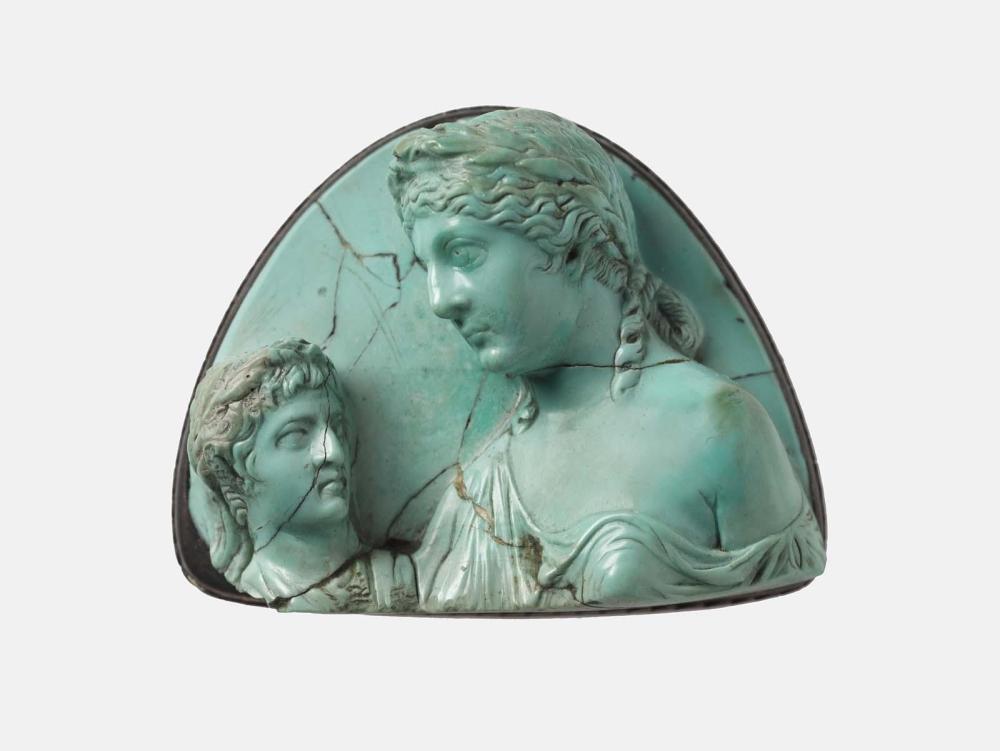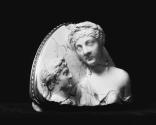Advanced Search
Cameo with Livia holding a bust of Augustus (?)
Roman
Imperial Period
A.D. 14–37
Medium/Technique
Turquoise
Dimensions
Overall: 3.1 x 3.8 x 1.6 cm (1 1/4 x 1 1/2 x 5/8 in.)
Credit Line
Henry Lillie Pierce Fund
Accession Number99.109
NOT ON VIEW
CollectionsJewelry, Ancient Greece and Rome
ClassificationsJewelry / Adornment – Cameos
People living in Rome, as well as in cities and towns throughout the empire, constantly encountered images of their emperors. A likeness of the reigning ruler was a fixture in virtually every public space-from places of assembly and business to baths, theaters, and temples. The succession of a new emperor to the throne might require thousands of portraits to be made quickly. The need to mass-produce imperial images gave rise to the creation of officially sanctioned "portrait types" with distinctive hairstyles and facial features, which were disseminated to serve as models for sculptors to generate additional replicas.
A marble head of Augustus, Rome's first emperor (reigned 27 B.C.-A.D. 14), wears a hairstyle with a row of comma-shaped locks all brushed to one side over the forehead; this coiffure is the primary characteristic of the "Forbes type," named after the donor of the piece. Probably set upon a life-size statue in a public place, this portrait of Augustus, ever youthful and imbued with a calm intensity, would have impressed all who came into its orbit with a sense of the emperor's commanding presence and authority.
Imperial portraits were also made on a more intimate scale, sometimes from precious or exotic materials, for private display and devotion. Although fragmentary, a unique cameo, carved of turquoise, is widely thought to portray Livia, the wife of Augustus-named priestess of her deified husband after his death-gazing down at a small bust-length sculpted portrait of him. In much the same way, the owner of this precious gem, whose intricate workmanship and lavish material suggest it might have been made for a member of the imperial court, must have looked with highest regard on the figures of the divine emperor and the first lady of Rome.
A marble head of Augustus, Rome's first emperor (reigned 27 B.C.-A.D. 14), wears a hairstyle with a row of comma-shaped locks all brushed to one side over the forehead; this coiffure is the primary characteristic of the "Forbes type," named after the donor of the piece. Probably set upon a life-size statue in a public place, this portrait of Augustus, ever youthful and imbued with a calm intensity, would have impressed all who came into its orbit with a sense of the emperor's commanding presence and authority.
Imperial portraits were also made on a more intimate scale, sometimes from precious or exotic materials, for private display and devotion. Although fragmentary, a unique cameo, carved of turquoise, is widely thought to portray Livia, the wife of Augustus-named priestess of her deified husband after his death-gazing down at a small bust-length sculpted portrait of him. In much the same way, the owner of this precious gem, whose intricate workmanship and lavish material suggest it might have been made for a member of the imperial court, must have looked with highest regard on the figures of the divine emperor and the first lady of Rome.
Catalogue Raisonné
Highlights: Classical Art (MFA), p. 174-175.
DescriptionBust of Livia in the guise of Venus Genetrix, with closely clinging drapery slipping off her left shoulder. Beside her is a youthful male head, which must originally have belonged to a bust or full-length figure, alternately identified as a bust of the deified Augustus, or as one of her sons, Tiberius or Drusus I.
The cameo has been set into a modern setting. The lower part of the gem is damaged, and a portion of the original has clearly been lost.
The cameo has been set into a modern setting. The lower part of the gem is damaged, and a portion of the original has clearly been lost.
ProvenanceWilliam Ponsonby, 2nd Earl of Bessborough (b. 1704 – d. 1793), London; George Spencer, 4th Duke of Marlborough (b. 1739 – d. 1817), Blenheim Palace; by descent within the family to John Winston Spencer-Churchill (b. 1822 – d. 1883), 7th Duke of Marlborough, Blenheim Palace [see note 1]; June 28-July 1, 1875, Marlborough Gems sale, Christie, Manson and Woods, London, lot 347, collection sold en bloc for £35,000 to David Bromilow (b. 1809 – d. 1898), Bitteswell Hall, Lutterworth; 1898, by descent to his daughter, Julia Harriet Mary Jary; June 26, 1899, sold by Mrs. Jary, Marlborough Gems sale, Christie, Manson and Woods, London, lot 403, sold for £330 to W. T. Ready for Edward Perry Warren (b. 1860 – d. 1928), London; 1899, sold by Edward Perry Warren to the MFA for $16,502 [see note 2]. (Accession Date: January 1, 1899)
NOTES:
[1] On the history of the Marlborough Gem collection, see the introduction to the 1875 Christie's auction catalogue and John Boardman, The Marlborough Gems (2010).
[2] This is the total price for MFA 99.101-99.119.
NOTES:
[1] On the history of the Marlborough Gem collection, see the introduction to the 1875 Christie's auction catalogue and John Boardman, The Marlborough Gems (2010).
[2] This is the total price for MFA 99.101-99.119.




